Family : Muraenidae

Text © Giuseppe Mazza

English translation by Mario Beltramini
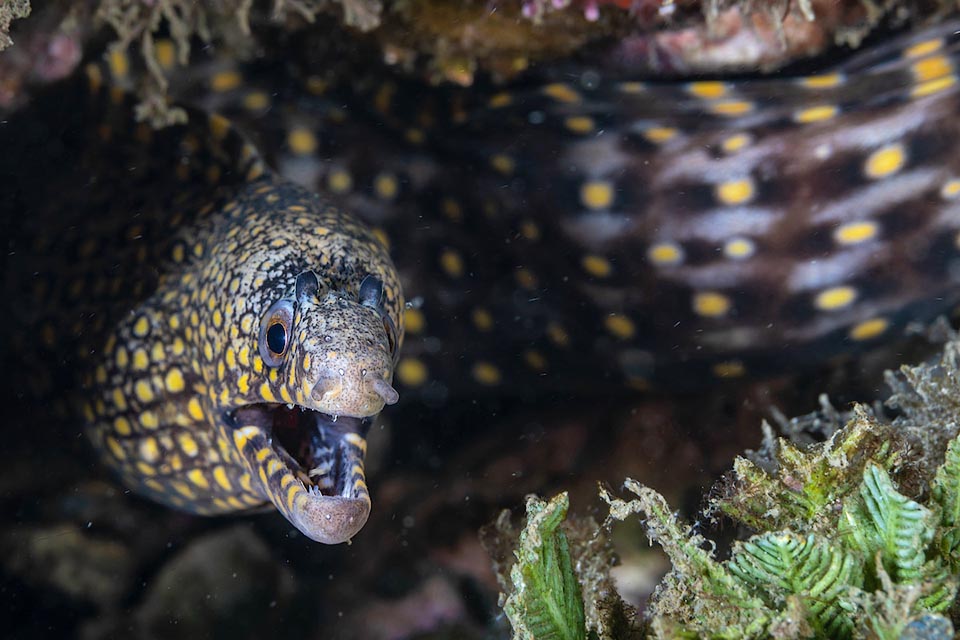
Mostly 35 cm long with a maximum of 61, Muraena lentiginosa lives in east Pacific, from the Gulf of California to Peru, Galapagos included © Allison & Carlos Estape
Muraena lentiginosa Jenyns, 1842 belongs to the class of the Actinopterygii, the ray-finned fishes, to the order of the Anguilliformes and to the family of the Muraenidae.
The name of the genus Muraena is that given by the old Romans to the Muraena helena, coming from the Greek “μύραινα” (mýraina) as reported by Aristotle.
The specific name lentiginosa, with freckles in Latin, refers to the characteristic rows of elegant dark edged circular yellow spots that have earned it also the common name of Jewel moray.
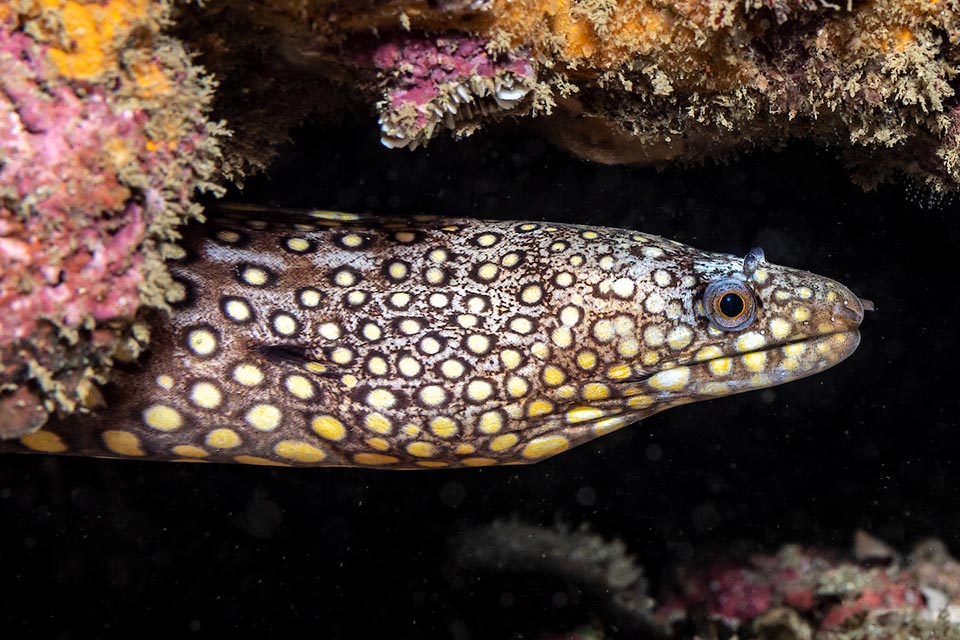
The specific term and the common one of Jewel moray refer to its elegant rows of yellow circular spots having a dark edge © Allison & Carlos Estape
Zoogeography
Muraena lentiginosa lives in the eastern Pacific. Starting from the Gulf of California, it is present along the coasts of Mexico, Guatemala, El Salvador, Honduras, Nicaragua, Costa Rica, Panama, Colombia, Ecuador and Peru, including Lobos de Afuera Island and the Galapagos.
Ecology-Habitat
It is usually found from 5 to 25 m of depth, in waters rich in rocky crevices and madreporic formations where it hides during the day.
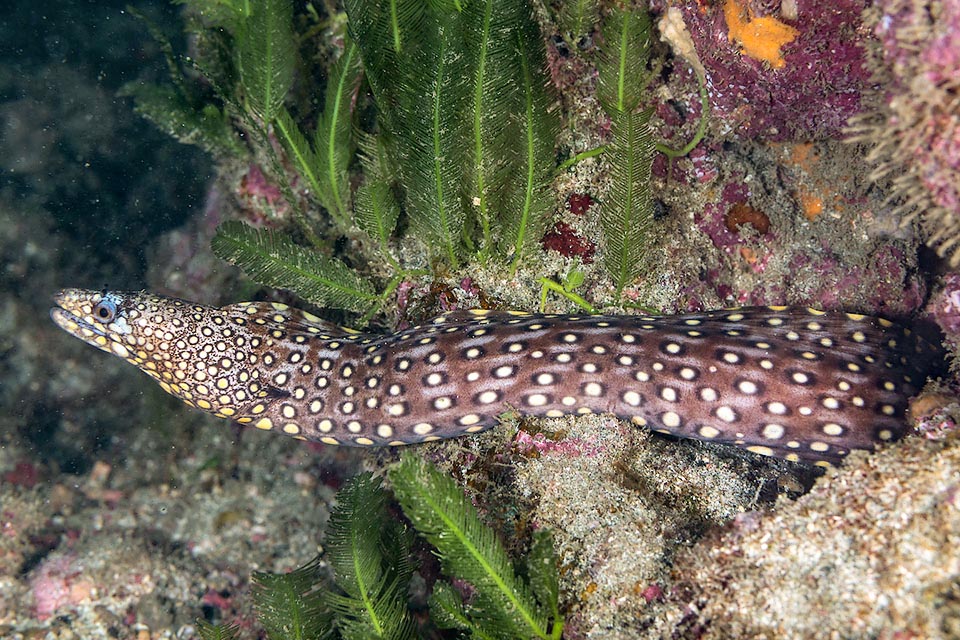
It frequents rocky and madreporic sites at 5-25 m of depth. It rests the day in a den and exits the evening hunting fishes and crustaceans © Allison & Carlos Estape
Morphophysiology
It is a small moray, usually 35 cm long, that may reach a maximum of 61 cm.
The head, laterally very compressed with sharp jaws, has relatively big eyes flanked by two nostrils, as tuberculate as those placed at the tip of the snout, for a very fine sense of smell that allows it to locate even in the darkness the animals it feeds on.
The jaws, equal and not arcuate, display on the sides only one row of thin and sharp teeth, pointing backwards and slightly hooked to retain the preys.
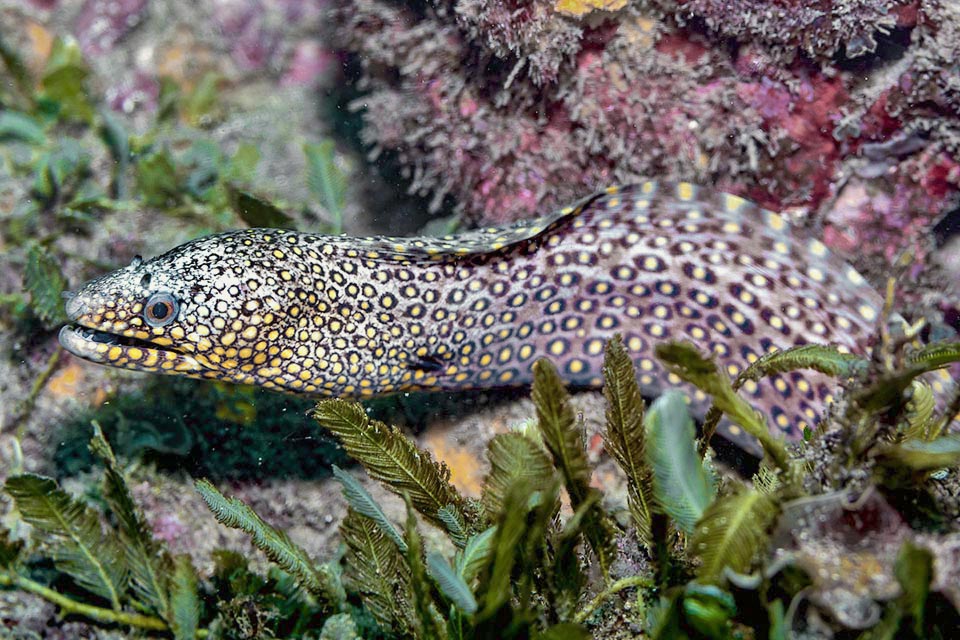
The gill orifice, from where goes out the air pushed by the mouth movement to oxygenate the gills, is hidden by a black dot on the neck © Allison & Carlos Estape
Like in all morays, the ventral and pelvic fins are absent. The dorsal, the caudal and the anal have merged in a unique long cutaneous crest, high and showy, used for an undulatory swimming.
There are no scales replaced by a mucus protecting these fishes from the skin parasites and allows them to enter without scratches into the holes of rocks and madrepores.
The morays do not have gills with opercula, but gill orifices: two simple holes located at the end of the snout on the extension of the jaw from where the air that has oxygenated the gills gets out, pushed by the mouth movement.
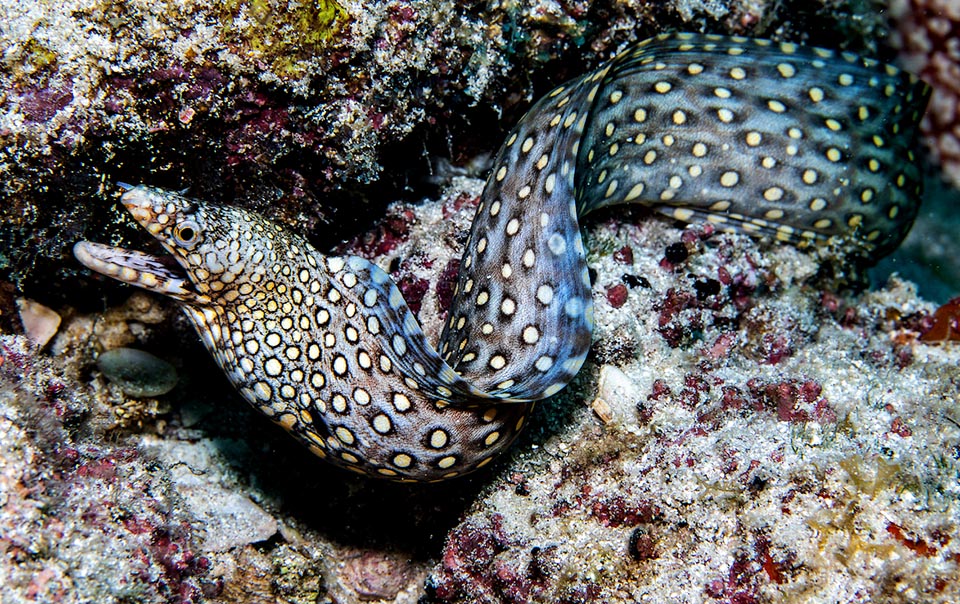
The head is very compressed laterally with pointed jaws and swims, like all morays, with undulatory movements of the body © Allison & Carlos Estape
In the Jewel moray these have the diameter of the eyes and are placed at the centre of a dark dot. Characteristic of the species is also the small black dot in the back corner of the mouth close to that, more conspicuous, white, on the lower jaw.
The background colour of the livery is usually brown, but may also be grey with bluish or reddish-violet tendencies.
The juveniles have a dark body and almost black head on which stand out, luminous, the eyes with their showy yellow iris that later on, in the adults, will get brown, at times with blue shades at the top and bottom. They don’t have yet the characteristic golden dots of the species but light blue specks, small on the head up to the gill orifice and then bigger and paler.
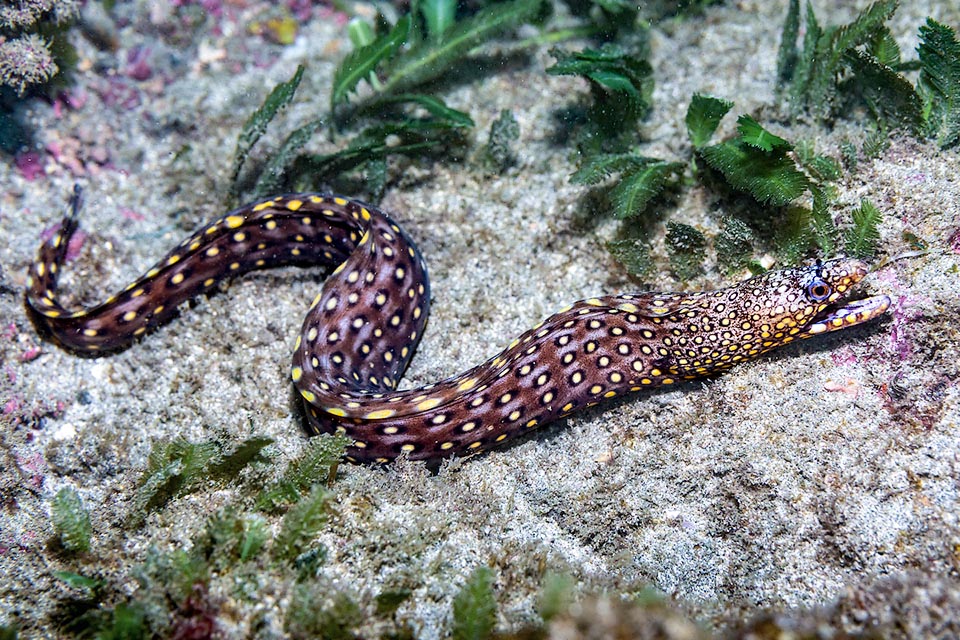
The livery background colour, usually brown, can be also bluish grey or reddish brown like in this instance © Allison & Carlos Estape
Ethology-Reproductive Biology
The Jewel moray spends most of the day in its den and goes out hunting mainly during the night. In addition to fishes it preys chiefly lobsters, shrimps and crabs.
It often plays as a team player with groupers like Mycteroperca rosacea or the small Alphestes immaculatus because four eyes, or six hunting in three, see better than two, and also the sense of smell of the moray has its importance. At the sight of 2 or 3 predators together, some terrified fishes abandon their hideouts and fleeing everywhere end up in the mouth of the moray or of the groupers.
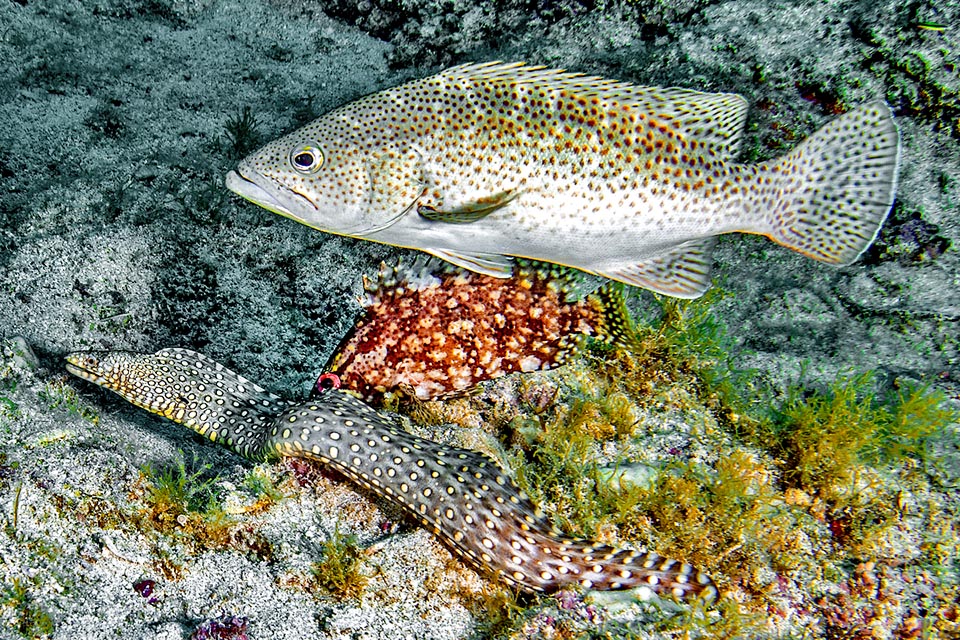
Muraena lentiginosa hunts often sided by groupers. Here it shares the loot with Mycteroperca rosacea and Alphestes immaculatus © Allison & Carlos Estape
Everyone benefits, and it seems that every day the latter wait for the moray to come out from the den.
As generally for the morays, also the reproduction of Muraena lentiginosa is largely shrouded in mystery. Eggs and larvae are known to be planktonic and that at a certain moment they get a characteristic form called leptocephalus, similar to a transparent leaf of willow being devoid of red blood cells, with very small head and protruding needle-shaped teeth.
The leptocephali do not catch zooplankton, like the normal larvae of the fishes, but seize tiny food particles carried by the currents. They can also swim backwards with rapid undulatory movements or even wrap on themselves on a ring assuming the appearance of a small wandering cylinder that renders them similar to gelatinous zooplankton, poorly palatable like the jellyfishes.
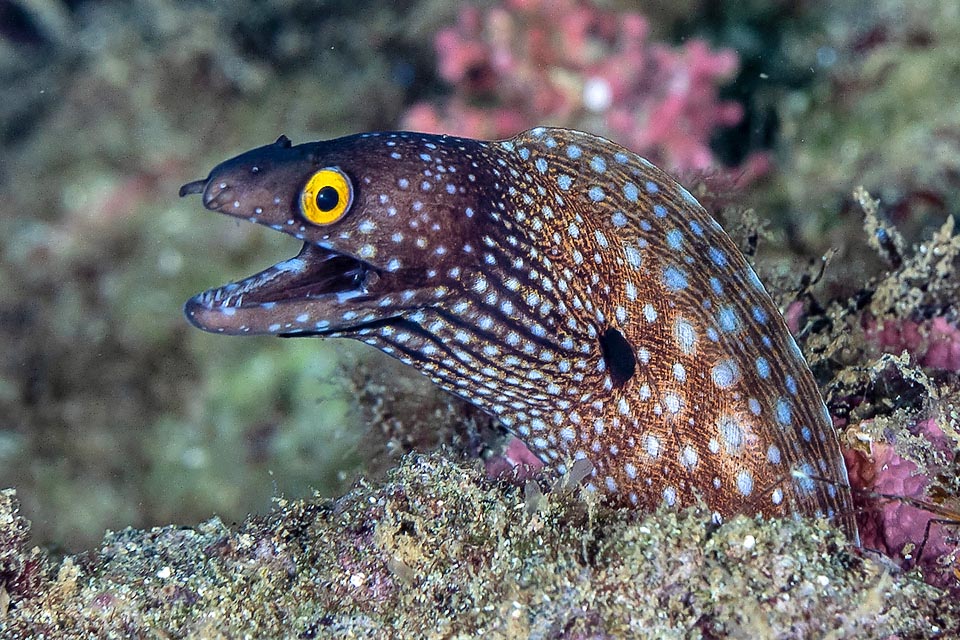
Juveniles, with bright yellow eyes, have a dark livery, especially on the head adorned by light blue spots, bigger and paler on the rest of the body © Allison & Carlos Estape
When they metamorphose, reaching the seabeds, the few centimetres long juveniles already have a shape similar to the adults. The resilience of the species is average with a minimum doubling time of the populations of 1,4-4,4 years, and the fishing vulnerability index, moderate, marks 44 on a scale of 100.
Consequently, Muraena lentiginosa appears as “Least Concern”, in the IUCN Red List publication concerning the species in danger of 2010, awaiting an update.
Synonyms
Muraena insularum Jordan & Davis, 1891.
→ For general information about FISH please click here.
→ For general information about BONY FISH please click here
→ For general information about CARTILAGINOUS FISH please click here.
→ To appreciate the BIODIVERSITY of BONY FISH please click here.
→ To appreciate the BIODIVERSITY of CARTILAGINOUS FISH please click here.
